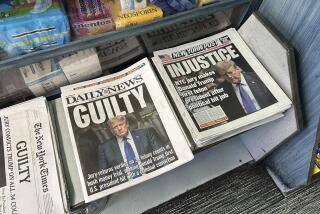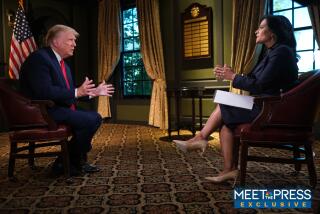Low-Key Bush Abandons Slick Image Strategy
- Share via
WASHINGTON — A few months ago, when Stephen Studdert signed on as an aide to newly elected President Bush, he was put in charge of selecting something known in White House jargon as “the theme of the week.”
Studdert was supposed to sift through the President’s agenda each week and pick out a single point the White House would emphasize in everything it said and did--from speeches and press briefings to television appearances and “photo opportunities.”
The idea, developed by earlier presidents and raised to a high science by Ronald Reagan, was to avoid internal babble and maximize the Administration’s impact on public opinion.
Diversity of Governing
Yet in the scattershot White House of George Bush, the task proved unexpectedly tough. By the week of April 17, Studdert was about ready to give up. Surveying the untidy bundle of unrelated matters the President considered important that week, the only theme Studdert could come up with was no theme at all: He called the week’s schedule “the diversity of governing.”
Studdert’s experience reflects one of the most striking features of Bush’s young presidency: With little fanfare, the new chief executive and his team have abandoned the elaborate, tightly controlled machinery developed in recent years to project, manipulate and polish a presidential image--machinery so pervasive and ingrained that it came to seem an indispensable tool of national leadership. Indeed, some considered it the soul of the presidency in the television age.
Instead, Bush has returned to media-massaging techniques perfected years before the audience of the television show “thirtysome-thing” were ever born--inviting reporters to lunch, to play horseshoes, see a movie or coo at the White House puppies.
In effect, some admirers say, Bush is posing a basic question: Can the President of the United States really lead simply by trying to develop popular policies--without slick television packaging and elaborate schemes to manipulate the news media? As a political consultant might put it, is substance enough?
High in Opinion Polls
With public opinion polls showing Bush’s popularity as high as 71%, the White House argues that the approach is working. The Wall Street Journal even quoted sources suggesting that Bush’s low-tech approach was actually the height of cunning, for it distinguished him from perceptions that Reagan was a shallow actor.
But the Bush approach is not without its critics. Some question whether the Bush team’s failure to communicate its vision for the future reflects the lack of anything to communicate.
“The one thing that’s missing at this point in this presidency is a sense of where this President wants to go,” said Republican political analyst David Keene of the American Conservative Union. “Being everyone’s next-door neighbor is, frankly, not sufficient for national leadership.”
Question Support
Others wonder whether Bush’s aversion to grand themes and dramatic gestures will leave him without a core of passionate supporters to fall back on if things turn sour at home or abroad. The problem with not communicating a vision is that it leaves you without a “political base for the long haul,” said former Reagan White House Communications Director David Gergen, now editor-at-large of U.S. News & World Report.
“We have seen presidents who were high up in the polls,” Gergen said, “but without a solid safety net of support there is an enormous potential to slide very fast. . . . You need symbols, things that people can relate to.”
Even now, he argued, people can remember moments about the Reagan era--the return of the hostages from Iran just after Reagan took office, his decision to decertify the air traffic controllers union, the 40th anniversary of the Normandy invasion. These came to represent something larger about the man and the country.
While Bush has succeeded in demonstrating his warmth, Gergen thinks his generally low-key approach may blend his message into the background. “It is important for the White House to see presidential activities as more than wallpaper and Muzak,” he said.
Bush advisers profess puzzlement at such complaints.
“Eight years ago, the press was beating up on the White House for managing the news,” said a senior White House staff member. “Eight years later, that same press corps is beating up on the White House for not managing the news.”
The media tactics represented by the “theme of the week” evolved over the past decade and more, but may have reached their zenith under Michael K. Deaver in the early Reagan years. It was then that media strategy and tactics became major considerations in almost every White House decision.
Reagan’s public actions were meticulously choreographed for maximum media impact. Moreover, to enhance White House influence over what subjects would dominate the news, his public appearances, comments and availability were strictly rationed and controlled so that the news media often had little choice but to use the images and comments Deaver and his lieutenants had planned.
Foreshadows Reagan
Reagan was not the first President to travel that road. Jimmy Carter brought advertising executive Gerald Rafshoon into the White House as an adviser on media and politics--the so-called “Secretary of Symbolism.”
Bush himself followed the advice of such experts during his campaign last year. He stuck with themes carefully scripted to work well on the emotional medium of television, such as the Pledge of Allegiance and the prison furlough program that released convict Willie Horton.
But with the campaign over, Bush began to change, arguing that running for office is different from governing.
In the early weeks of his presidency, advisers talked about Bush’s wanting to establish his “values” and themes. He spoke frequently about education, drug abuse and ethics in government and business.
But once he had done that, even this pattern to his activities--and thus too the message he sought to leave with the American public--became less clear.
To hear senior aides tell it, communications strategy is something that no longer always comes up in the morning session of top staff members. Rather, it is often catch-as-catch-can.
Small-Scale Activities
Bush has devoted much of his schedule to small-scale activities with which he feels comfortable: frequent trips outside of Washington that generally do not involve major speeches, ceremonies in the Rose Garden and personal encounters with reporters.
The result has been a less visible President.
According to the Center for Media and Public Affairs in Washington, during his first 60 days in office, Bush received about one-half the network television coverage Reagan received during the same period in 1981, and about 57% of the coverage given Jimmy Carter during the first 60 days of Carter’s tenure.
When Bush announced his much-anticipated plan for education, for instance, he did so with only a Rose Garden ceremony at which no children were even on stage--and the New York Times put the story inside. When he delivered on a campaign promise to help working parents meet child-care needs, Bush left it to spokesman Marlin Fitzwater to disclose the details on camera.
Bush aides say their approach to communications is designed for the long haul.
First, Bush’s approach fits the man. Just as the previous Administration’s media strategies were developed to take advantage of Reagan’s singular talents for delivering a script on television, Fitzwater said, “What I have tried to do is develop techniques for communicating that take advantage of President Bush, and they’re quite different.”
Outlines New Approach
Viewing Bush as “good on his feet” and comfortable with “the give and take of dealing with the press,” Fitzwater wrote a memorandum in December outlining new ways that the President could be accessible to the media. Since then, Bush has used such approaches as conducting interviews with small groups of reporters, dropping into the White House pressroom on short notice and inviting reporters to impromptu lunches.
The idea, in part, was to avoid some of the episodes of the Reagan White House that Bush had thought undignified, such as having questions shouted at the President during photo sessions with foreign dignitaries and over the whirring roar of a waiting helicopter.
Second, Bush’s relatively low profile suits his more quiet and conciliatory approach to governing.
Where Reagan as a Washington outsider used the club of public opinion to pressure Congress to support often-controversial programs, Bush so far has relied on face-to-face meetings, often in private, and usually involving compromise. The back-room agreement to sustain aid to the Nicaraguan Contras and the negotiations on the federal budget are two examples.
White House Communications Director David F. Demarest talks about the small-scale events over time creating “a mosaic of impressions the public will have of the presidency.”
Or as White House Chief of Staff John H. Sununu put it: “The President’s agenda has a long-term perspective in it.” And he and his colleagues are certain the public will see it.
Doubt Persists
Yet doubt persists over how well-thought-out Bush’s approach to communications really is.
“There was never a conscious decision made initially to present Bush differently from President Reagan,” said one senior aide privately.
“The communications plan for this Administration is not in the files,” said another.
Instead, it is a practical matter--the only approach that Bush will allow. And for Bush, news media manipulation is simply not a high priority.
He is a man, as one aide put it, with “a healthy ambivalence toward the headlines.”
It is no surprise. To get to the White House, this President overcame the tag of being a wimp, a verbal bumbler and a certain loser to, at various times, Bob Dole and Michael S. Dukakis.
Like others who have entered the White House by defying the consensus, Bush has developed a natural skepticism toward the conventional wisdom about how to build public support through communications. Some at the senior levels at the White House seem almost scornful of letting media strategy dictate overall planning.
When asked why the President had not considered touring the devastation of the Alaska oil spill, for instance, one senior adviser said: “I don’t think he has to embrace an oiled-up sea otter. . . . There is something tawdry about going up there and posing with an oil spill. There is a show business aspect that has nothing to do with cleaning it up.”
More to Read
Get the L.A. Times Politics newsletter
Deeply reported insights into legislation, politics and policy from Sacramento, Washington and beyond. In your inbox three times per week.
You may occasionally receive promotional content from the Los Angeles Times.










